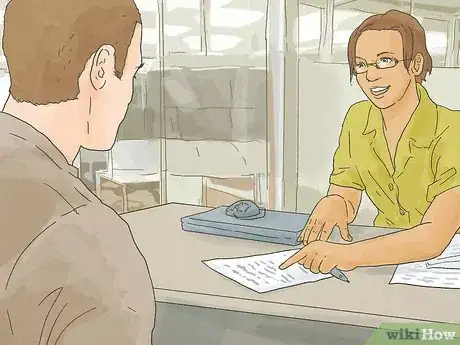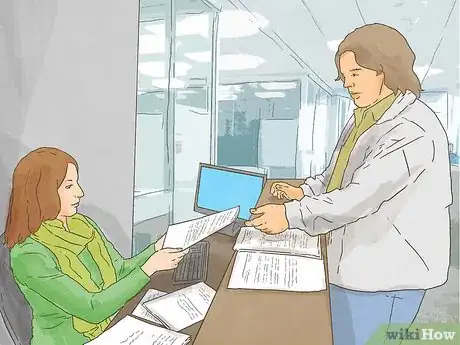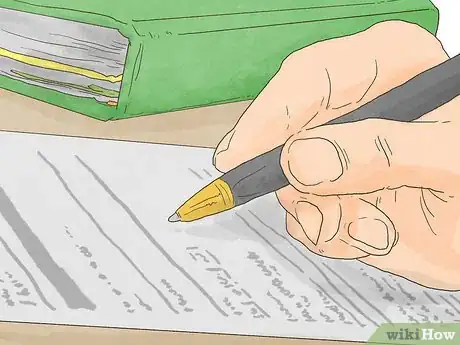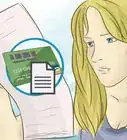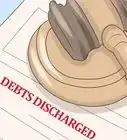This article was co-authored by Michael R. Lewis. Michael R. Lewis is a retired corporate executive, entrepreneur, and investment advisor in Texas. He has over 40 years of experience in business and finance, including as a Vice President for Blue Cross Blue Shield of Texas. He has a BBA in Industrial Management from the University of Texas at Austin.
There are 10 references cited in this article, which can be found at the bottom of the page.
wikiHow marks an article as reader-approved once it receives enough positive feedback. In this case, 93% of readers who voted found the article helpful, earning it our reader-approved status.
This article has been viewed 401,293 times.
For many people who are completely over their head in debt, filing for bankruptcy can provide relief and a fresh financial start. Most United States citizens are able to file for either Chapter 7 or Chapter 13 bankruptcy. This article discusses Chapter 7, in which a court settles most of the debts involved, partially by selling off the debtor's unprotected assets and distributing the proceeds to creditors. [1] Although the process may seem complicated, with proper legal advice or research it is reasonably simple to navigate.
Steps
Getting Ready to File
-
1Determine if bankruptcy is the best option for you. Bankruptcy is not something that you should undertake lightly, but you should consider it if you cannot repay your debts and do not foresee any changing circumstances. That said, you do not have to be completely broke to file. Talk with an attorney before you raid your retirement funds and/or refinance your home.
- The decision to file for bankruptcy should be made only as a last resort, as it comes at a high cost regarding your future creditworthiness. Before filing you should determine whether enough of your debts would be discharged to make the process worthwhile. Generally bankruptcy filings are made by people who have amassed very high medical bills or debt from credit cards, personal loans, or auto accidents. These debts, among others, are legally dischargeable in Chapter 7 bankruptcy. [2]
- Understand that Chapter 7 bankruptcy will allow a court to seize your assets to meet the demands of creditors. Possessions like your home, retirement funds, public benefits, professional tools, and certain personal possessions are protected and cannot be seized. Be prepared, however, to let go of certain non-essential or discretionary items such as sports cars, large-screen televisions, and high-end jewelry. Property exempt from seizure can vary by state, so be sure to check your state's laws before deciding to file. [3]
-
2Find out if you qualify for Chapter 7 bankruptcy. This will depend on your income as it compares to other families of similar size. Essentially the court checks to see that you really don't have enough income to pay your debts. [4] If you fail to qualify, your only option would be a Chapter 13 "debt consolidation".
- Certain debts are not dischargeable through the Chapter 7 bankruptcy process. These include debt incurred in bad faith as the result of fraudulent or grossly negligent, pre-petition actions as well as certain tax and student-loan debt (in most cases). [5] Check to see if your debts are covered under Chapter 7 bankruptcy before filing.
Advertisement -
3Decide whether to hire a bankruptcy attorney. Such a person can help you determine whether Chapter 7 is your best option and can guide you through the entire process. Hiring an attorney for this process will cost you roughly $1,200. The price will depend on your location and the complexity of your case. [6]
- Many attorneys expect their fee to be paid right away. This is because bankruptcy proceedings may discharge outstanding legal fees.
- Filing without a lawyer is an option that's much cheaper than filing with one. However, you should consider that a good lawyer can help persuade the court to settle more of your debts or better protect your personal property from seizure by the court. Even when filing pro se, (without a lawyer), you are still required to pay the $335 Chapter 7 bankruptcy filing fee as well as the cost of pre-filing credit counseling and a personal-finance-management class, each of which may cost up to $50. Should you decide to file for Chapter 7 bankruptcy without a lawyer, see How to File Chapter 7 Bankruptcy Without a Lawyer.
Starting the Bankruptcy Filing Process
-
1Complete mandatory credit counseling. The federal government requires that debtors receive credit counseling prior to filing for bankruptcy. This will cost between $20 and $50, but the fee will be waived if you are unable to pay. [7] If your case is filed without the credit counseling, it will be dismissed before you seek discharge of your pre-petition indebtedness. You can find a list of approved counselors through the Justice.gov website. [8]
-
2Complete required paperwork. Along with the petition itself, you will file supporting documents:
- A schedule of assets and liabilities
- A list of current income and expenditures
- A list of all debts to be included in the bankruptcy
- An accounting of executory contracts and unexpired leases
- A schedule of exempt assets
- Per the revised bankruptcy code, a means test which is used by the trustee to determine possible abuse of bankruptcy law.
- You can find the appropriate forms online for free. [9]
- The list of creditors, account numbers, addresses, and amounts owed should be as complete as possible to avoid problems after the bankruptcy. Creditors who are not notified by the court will attempt to collect despite the bankruptcy.
- Debts should also include any co-signed liabilities or outstanding guarantees even when a loan is in good shape. Otherwise, creditors may seek payment.
-
3File the petition, your completed paperwork, and your credit-counseling certificate with the bankruptcy court. As the debtor, you must file a petition with the court serving the area where you live (or where you own a business or have most of your assets). Once the petition is filed, most legal actions are “stayed," which means most of your creditors will be unable to start or continue lawsuits, garnish wages, or contact you demanding payment. If you did not apply for a fee waiver, the court will require a $335 payment by cash or money order. [10] The filing fee must be paid in full when you file your initial petition, although some courts allow the filing fee to be paid in installments.
Making Sure Your Filing Runs Smoothly
-
1Provide your bankruptcy trustee with copy of your most recent paycheck stubs and your most recent tax return. In some cases you must provide the trustee with these documents at least seven days before your meeting with creditors. Check with your appointed trustee or your lawyer to clarify what documents the trustee needs. [11]
- The bankruptcy trustee will oversee your filing process and is assigned to you after you file your initial documents. This trustee is not your lawyer or the judge but another official appointed by the court or your creditors to ensure that the bankruptcy process runs smoothly.
-
2Attend the meeting of creditors. At least 21 but no more than 40 days after the petition is signed, a meeting with creditors will be held. This is also called a 341 meeting. You must attend, and the people you owe will be able to ask you any questions regarding your financial affairs and property. This rarely happens, especially if most of your debt is unsecured (not backed with collateral like your home or car). Credit card companies will not send representatives to such a meeting. However, people from companies or parties whom you owe money for your house or car may be present. [12]
- This meeting will be overseen by your Chapter 7 trustee. He or she will instruct you on what to bring to this meeting, but you will typically need the following documents: [13]
- copies of a recorded mortgage
- car titles
- property deeds
- bank statements
- tax returns
- pay stubs
- This meeting will be overseen by your Chapter 7 trustee. He or she will instruct you on what to bring to this meeting, but you will typically need the following documents: [13]
-
3Complete your post-filing, personal-financial-management course. You can complete this course only after your case is filed and must do so within 45 days of the creditor's meeting. This is not the credit-counseling course you took when you submitted your paperwork. This course can vary in cost from free to about $50. Links to the trustee-approved providers are listed at [justice.gov]. If you do not do this, you risk having your case dismissed. Submit the certificate of completion as instructed in the correspondence to you.
-
4File motions or objections as necessary. While your case is ongoing, there may be additional claims made against you that you can dispute. For example, a car-loan creditor may claim a larger amount owed than your submitted documents show. This will have to be resolved using proper legal procedures. Once again it's advisable to seek professional legal advice. Keep in mind that you will be allowed to make such motions only while your case is open. Don't wait until after it has closed.
-
5Wait for final correspondence saying your debts are discharged. After all objections and motions are resolved, your case will be legally processed, and your creditors will receive notice of your (hopefully) successful bankruptcy filing. This will be a minimum of 61 days after your meeting of creditors.
-
6Get yourself back on track. At the conclusion of the bankruptcy process, you are discharged. You are no longer liable for discharged debts, and creditors cannot take any action against you. You are now ready to start rebuilding your credit.
- Even though all debts are discharged, certain debts may be "reinstated" as the result of creditor pressure. If a debt is reinstated, it is no longer discharged but rather continues under the same terms as before the bankruptcy proceedings.
Warnings
- It is possible that the trustee will determine that your case does not qualify for a Chapter 7 bankruptcy. The trustee can recommend the Chapter 7 case be converted to a Chapter 13 bankruptcy, which means you will have to make payments to the trustee in order to pay off your debts.⧼thumbs_response⧽
- Any creditors or debts not listed in the paperwork filed with the court will be exempt from the bankruptcy filing. That means they will still be able to seek recompense for your debts even after this process is complete. Be sure to include all relevant debts and creditors when filing.⧼thumbs_response⧽
- If your Chapter 13 bankruptcy is dismissed voluntarily and the automatic stay was modified previously by a creditor, you must wait six months before re-filing Chapter 13.⧼thumbs_response⧽
References
- ↑ http://www.nolo.com/legal-encyclopedia/bankruptcy-faq-29047-2.html
- ↑ http://www.nolo.com/legal-encyclopedia/debt-discharged-chapter-7-bankruptcy.html
- ↑ http://www.nolo.com/legal-encyclopedia/bankruptcy-faq-29047-2.html
- ↑ http://www.nolo.com/legal-encyclopedia/chapter-7-bankruptcy-eligibility-29701.html
- ↑ http://www.uscourts.gov/FederalCourts/Bankruptcy/BankruptcyBasics/DischargeInBankruptcy.aspx
- ↑ http://www.natlbankruptcy.com/how-much-does-it-cost-to-file-bankruptcy/
- ↑ http://www.nolo.com/legal-encyclopedia/bankruptcy-filing-fees-costs.html
- ↑ http://www.justice.gov/ust/eo/bapcpa/ccde/cc_approved.htm justice.gov
- ↑ http://www.uscourts.gov/FormsAndFees/Forms/BankruptcyForms.aspx
- ↑ http://www.natlbankruptcy.com/how-much-does-it-cost-to-file-bankruptcy/
- ↑ http://www.nolo.com/legal-encyclopedia/meeting-creditors-chapter-7-bankruptcy.html
- ↑ http://www.nolo.com/legal-encyclopedia/meeting-creditors-chapter-7-bankruptcy.html
- ↑ http://www.nolo.com/legal-encyclopedia/meeting-creditors-chapter-7-bankruptcy.html
- ↑ http://www.nolo.com/legal-encyclopedia/options-if-you-cant-afford-chapter-7-bankruptcy-lawyer.html
About This Article
To file for chapter 7 bankruptcy, start by completing the mandatory credit counseling, which costs $20-$50. Once you complete your counseling, you can begin your paperwork, which includes a schedule of assets and liabilities, a list of current income and expenditures, and a list of all debts. After you finish your paperwork, you can file your petition, completed paperwork, and your credit-counseling certificate with the bankruptcy court. Unless you file for a waiver, you’ll also have to pay a $335 filing fee. To learn how to complete the post-filing, personal-financial-management course, keep reading!



